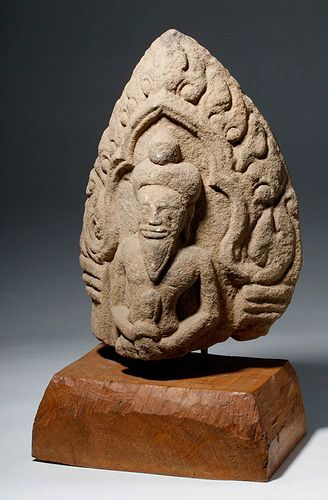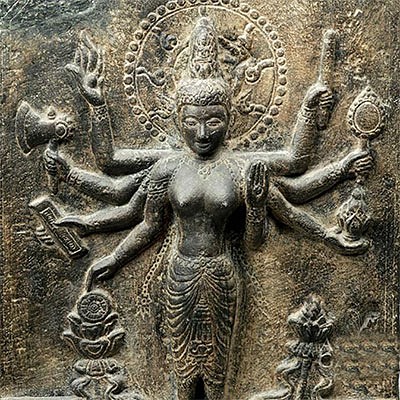6th C. Thai Sandstone Temple Fragment
Lot 30
About Seller
Artemis Fine Arts
686 S Taylor Ave, Ste 106
Louisville, CO 80027
United States
Selling antiquities, ancient and ethnographic art online since 1993, Artemis Gallery specializes in Classical Antiquities (Egyptian, Greek, Roman, Near Eastern), Asian, Pre-Columbian, African / Tribal / Oceanographic art. Our extensive inventory includes pottery, stone, metal, wood, glass and textil...Read more
Categories
Estimate:
$2,400 - $3,600
Absentee vs Live bid
Two ways to bid:
- Leave a max absentee bid and the platform will bid on your behalf up to your maximum bid during the live auction.
- Bid live during the auction and your bids will be submitted real-time to the auctioneer.
Bid Increments
| Price | Bid Increment |
|---|---|
| $0 | $25 |
| $300 | $50 |
| $1,000 | $100 |
| $2,000 | $250 |
| $5,000 | $500 |
| $10,000 | $1,000 |
| $20,000 | $2,500 |
| $50,000 | $5,000 |
| $100,000 | $10,000 |
| $200,000 | $20,000 |
About Auction
By Artemis Fine Arts
Feb 4, 2021
Set Reminder
2021-02-04 10:00:00
2021-02-04 10:00:00
America/New_York
Bidsquare
Bidsquare : CLEARANCE Asian | Antiquities | Ethnographic
https://www.bidsquare.com/auctions/artemis-gallery/clearance-asian-antiquities-ethnographic-6361
Featuring discounted pricing on Asian art, classical antiquities from Egypt, Greece, Italy, and the Near East...plus Pre-Columbian, Tribal, Russian Icons, Spanish Colonial, Fine Art, more! Starting prices have been reduced up to 65% from original auction prices - perfect for dealers and collectors! Artemis Fine Arts info@artemisfinearts.com
Featuring discounted pricing on Asian art, classical antiquities from Egypt, Greece, Italy, and the Near East...plus Pre-Columbian, Tribal, Russian Icons, Spanish Colonial, Fine Art, more! Starting prices have been reduced up to 65% from original auction prices - perfect for dealers and collectors! Artemis Fine Arts info@artemisfinearts.com
- Lot Description
**Originally Listed At $2000**
Southeast Asia, Thailand, ca. 6th to 8th century CE. A brown-grey sandstone temple fragment, triangular in shape, carved in relief to show a bearded man wearing a large headdress standing and holding what appears to be the hilt of a sword (the bottom is missing below the guard) with a flared hilt. Around him is a similarly carved relief frame of what appears to be an ornate triangular lintel and twin columns of a doorway. Who is the man? It seems likely that he is Akkhot (also known as Agastya or Agasti/Agathiyar in other regions), a revered poet, sage, and hermit in both Buddhist and Hindu tradition. Hermits, known as rishi, are common subjects of early sculpture in northern Thailand. The rishi are so called because they are the authors of the hymns of the Sanskrit Rigveda. The hat and beard of this figure are the indicators of his possible identity; however, this area and time period remain understudied and so it is difficult to identify him with certainty. Comes with custom stand. Size: 11.75" W x 15.8" H (29.8 cm x 40.1 cm); 19.75" H (50.2 cm) on included custom stand.
Northern Thailand, as part of the Maritime Silk Road, developed far-reaching trading contacts during this period that brought Hindu and Buddhist traditions into southeast Asia. Local rulers took these new religions and began to create larger kingdoms on the basis that they were god kings, known as devarajas, usually incarnations of Vishnu and Shiva. The artistic output at the time reflected this cultural milieu and the introduction of these two religions, with their cosmologies often mixed or placed alongside each other.
Provenance: private Boulder, Colorado, USA collection, purchased in 1998
All items legal to buy/sell under U.S. Statute covering cultural patrimony Code 2600, CHAPTER 14, and are guaranteed to be as described or your money back.
A Certificate of Authenticity will accompany all winning bids.
We ship worldwide and handle all shipping in-house for your convenience.
#117793Surface weathering and abrasion; back shows signs of being cut away from another piece, and the bottom terminates in a broken end.Condition
- Shipping Info
-
All shipping is handled in-house for your convenience. Your invoice from Artemis Gallery will include shipping calculation instructions. If in doubt, please inquire BEFORE bidding for estimated shipping costs for individual items.
-
- Buyer's Premium



 EUR
EUR CAD
CAD AUD
AUD GBP
GBP MXN
MXN HKD
HKD CNY
CNY MYR
MYR SEK
SEK SGD
SGD CHF
CHF THB
THB

















